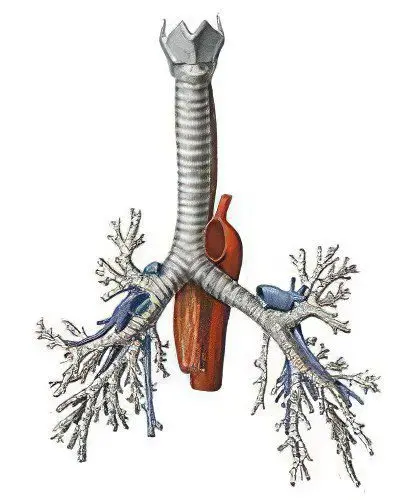What is tracheitis?

Tracheitis is an inflammation of the lining of the trachea. Depending on the characteristics of the course, acute and chronic tracheitis are distinguished.
Acute tracheitis is usually combined with other diseases of the nasopharynx (acute rhinitis, laryngitis and pharyngitis). In acute tracheitis, there is swelling of the trachea, hyperemia of the mucosa, on the surface of which mucus accumulates; sometimes petechial hemorrhages can occur (with influenza).
Chronic tracheitis often develops from an acute form. Depending on the changes in the mucous membrane, it has two subspecies: hypertrophic and atrophic.
With hypertrophic tracheitis, the vessels dilate and the mucous membrane swells. Mucus secretions become intense, purulent sputum appears. Atrophic chronic tracheitis causes thinning of the mucous membrane. It becomes gray in color, smooth and shiny, can be covered with small crusts and cause a strong cough. Often, atrophic tracheitis occurs along with atrophy of the mucous membrane of the respiratory tract located above.
Causes of tracheitis
Acute tracheitis most often develops as a result of viral infections, sometimes the cause is staphylococcus aureus, streptococcus, intoxication, and so on. The disease can occur due to hypothermia, inhalation of dry or cold air, harmful gases and vapors that irritate the mucous membrane.
Chronic tracheitis is often found in heavy smokers and drinkers. Sometimes the cause of the pathology is heart disease and kidney disease, emphysema, or chronic inflammation of the nasopharynx. The number of tracheitis diseases increases in the autumn and spring periods.
Symptoms of tracheitis

Among the most common symptoms of tracheitis is a painful dry cough that worsens at night and in the morning. The patient coughs with deep breaths, laughter, sudden movements, changes in temperature and humidity of the environment.
Coughing attacks are accompanied by pain in the throat and sternum. The breathing of patients is shallow and frequent: in this way they try to limit their respiratory movements. Often tracheitis is accompanied by laryngitis. Then the voice of the sick person becomes hoarse or hoarse.
Body temperature in adult patients is slightly increased in the evening. In children, fever can reach 39 °C. Initially, the amount of sputum is insignificant, its viscosity is noted. As the disease progresses, mucus and pus are discharged with sputum, its amount increases, pain when coughing subsides.
If, along with tracheitis, the bronchi are also subject to inflammation, the patient’s condition worsens. This disease is called tracheobronchitis. Coughing attacks become more frequent, it becomes more painful and painful, the body temperature rises.
Tracheitis can lead to complications in the lower respiratory tract (bronchopneumonia).
Diagnosis of tracheitis is carried out with the help of an examination: the doctor examines the patient’s throat with a laryngoscope, listens to the lungs.
Treatment of tracheitis
Treatment of tracheitis involves the elimination of pathogenic factors that caused the development of the disease. First of all, etiotropic therapy is carried out. Antibiotics are used for bacterial tracheitis, antiviral agents for viral tracheitis, and antihistamines for allergic tracheitis. Expectorants and mucolytics (bromhexine) are used. With a strong dry cough, it is possible to prescribe antitussive drugs.
It is recommended to carry out inhalations using inhalers and nebulizers using pharmacy solutions.
Adequate treatment of tracheitis guarantees recovery in 1-2 weeks.









